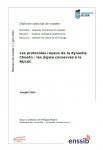Les protocoles royaux de la dynastie Chosŏn : les ŭigwe conservés à la BULAC
- Auteur : Cho, Jungki
- Directeur de mémoire ou de thèse : Martin, Philippe
- Description : Mémoire de Master 2 Cultures de l'écrit et de l'image s'étant attaché à étudier la collection de ŭigwe de la BULAC, en essayant d'en extraire les éléments témoins de l'évolution du pouvoir durant différentes périodes.
- Résumé en français : Le terme ŭigwe (儀軌) désigne les documents officiels sur les événements royaux organisés à la cour sous la dynastie Chosŏn (1392-1910). La BULAC conserve six titres, huit exemplaires d’ŭigwe : Wŏnhaeng ŭlmyo chŏngni ŭigwe, le premier ŭigwe imprimé à caractères mobiles en 1797 ; trois exemplaires de Hwasŏng sŏngyŏg ŭigwe (une édition complète, une édition incomplète imprimés en 1801 et une reproduction en cyanotype) ; le manuscrit Tyŏngni ŭigwe qui est une copie unique ; Chagyŏngjŏn chinjak chŏngrye ŭigwe imprimé en 1827 ; les deux Chinch'an ŭigwe imprimés en 1877 et en 1887. Cette étude analyse les éléments bibliographiques de ces ŭigwe, notamment le contexte historique, la provenance, la matérialité, le contenu, les illustrations et le détail des publications. La publication d’ŭigwe était une tâche significative de la cour. L’ŭigwe a été compilé dans le but de systématiser les cérémonies royales, voir même consolider le pouvoir royal. La publication est alors liée à la situation politique de l’époque et chaque élément matériel de livre est décidé de manière significative. L'analyse de cette collection montre les changements et les tendances des publications ŭigwe de la fin du XVIIIe siècle à la fin du XIXe siècle
- Résumé en anglais : The term ŭigwe (儀軌) refers to official records of royal events held at court during the Chosŏn dynasty (1392-1910). The BULAC conserves six titles, eight copies of ŭigwe: Wŏnhaeng ŭlmyo chŏngni ŭigwe, the first ŭigwe printed with movable type in 1797; three copies of Hwasŏng sŏngyŏg ŭigwe (one complete edition, one incomplete edition printed in 1801 and one cyanotype reproduction); the Tyŏngni ŭigwe manuscript which is the only copy; Chagyŏngjŏn chinjak chŏngrye ŭigwe printed in 1827; the two Chinch'an ŭigwe printed in 1877 and 1887. This study analyzes the bibliographic elements of these ŭigwe, in particular the historical context, provenance, materiality, content, illustrations and details of the publications. The publication of ŭigwe was a significant task of the court. The ŭigwe was compiled with the aim of systematizing royal ceremonies, and even consolidating royal power. The publication is then linked to the political situation of the time and each material element of the book is decided with meaning. Analyzing this collection shows changes and trends in publication of ŭigwe from the end of the 18th century to the end of the 19th century.
- Collection : Mémoires Master "Culture de l'écrit et de l'image"
- Thèmes : Collections , Documents écrits , Collections patrimoniales
-
Label :
Palmes de l'enssib

- Licence de diffusion : Tous droits réservés
- Format : Fichier Adobe PDF
- Date de création : 08 juin 2022
- Étendue : 148 p.
- Étendue : 4,35 Mo
- Date de publication : 09 juin 2022
- Langue : fr
- Éditeur ou organisme : Enssib
- Sujet(s) : ŭigwe, BULAC, dynastie Chosŏn, livre ancien coréen, Wŏnhaeng ŭlmyo chŏngni ŭigwe, Hwasŏng sŏngyŏg ŭigwe, Tyŏngni ŭigwe, Chagyŏngjŏn chinjak chŏngrye ŭigwe, Chinch'an ŭigwe
- Type de ressource : text
- Type de mémoire : Mémoire de recherche
- Diplôme : Master 2 CEI "cultures de l’écrit et de l’image"

